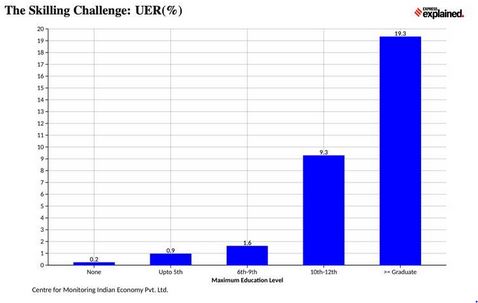Note4Students
From UPSC perspective, the following things are important :
Prelims level: Not much
Mains level: Unemployment in India

PM has yet again underscored the importance of a skilled workforce for achieving the goal of becoming Atma-nirbhar Bharat. India still continues to be a country that faces one of the highest shortages of skilled workforce.
Unemployment vs Skills

- On one hand, companies in India face an acute shortage of skilled manpower and, on the other, India has millions of educated unemployed.
- The data for this chart is for the January to April 2021 period, when the overall unemployment rate in the country was 6.83%.
- In comparison, those with graduation (or even higher degrees) face almost three times the unemployment level.
- At over 19% unemployment rate, one in every five Indians who graduate (or even better) is unemployed.
What explains this contradiction?
- The lack of skill is definitely the only answer.
What is Skilling?

- National Council of Applied Economic Research, 2018 — aptly titled “No time to lose”.
- This report explains that there are three types of skills.
- Cognitive skills: basic skills of literacy and numeracy, applied knowledge and problem-solving aptitudes, and higher cognitive skills such as experimentation, reasoning, and creativity.
- Technical and vocational skills: physical and mental ability to perform specific tasks using tools and methods in any occupation.
- Social and behavioral skills include working, communicating, and listening to others.
- Different levels of these three types of skills can be combined to further classify skills into foundational, employability, and entrepreneurial skills.
What is the scale of the skilling challenge facing India?
According to the 2018 report by NCAER, India had about 468 million people in its workforce.
- Informal sector: Around 92% of them were in the informal sector.
- Illiteracy: Around 31% were illiterate, only 13% had primary education, and only 6% were college graduates.
- No vocational training: Further, only about 2% of the workforce had formal vocational training, and only 9% had non-formal vocational training.
- Out of more than 5 lakh final year bachelors students aged 18–29 who were surveyed, around 54% were found to be “unemployable”.
Opportunities for India
- India has entered a demographic sweet spot that will continue for another two to three-decade.
- There is a great opportunity for India to improve both its social and economic outcomes if a higher number of workers are productively employed.
What is at stake?
- If the skilling issue is not resolved, India risks forfeiting its so-called “demographic dividend”.
- But whether this will turn into a demographic dividend or not will depend entirely on how many of those in the working-age bracket are working and becoming prosperous.
- If they are not in well-paying jobs, the economy would not have the resources to take care of itself since with each passing year, the proportion of dependents will continue to rise after 2040.
- To put it simply, to attain its rightful place and realize its aspirations, India must become rich before it gets old.
The skilling paradox
- Indians have excelled in technical expertise at the global level — be it medicine or engineering. Then what explains India’s domestic skilling paradox?
- A big part of the trouble is the starting condition. Over 90% of India’s workforce is in the informal sector.
India is trapped in a vicious cycle:
- Greater workforce informality leads to lower incentives to acquire new skills. Faced with inadequately skilled workers, businesses often choose to replace labor with machinery.
- That’s because “skilled labor and technology are complementary, but unskilled labor and technology are substitutes”.
- This, in turn, leads to still fewer formal jobs.
What can be done to break this cycle?
- A distinct disadvantage with India’s approach towards skilling has been to ignore and match the demands of the market.
- For the most part, skills have been provided in a top-down fashion.
- Given the way market demands fluctuate — for instance, how the Covid pandemic has upended supply chains — skilling efforts must try to anticipate the needs of the market.
Get an IAS/IPS ranker as your 1: 1 personal mentor for UPSC 2024
